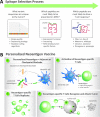The Role of Mass Spectrometry and Proteogenomics in the Advancement of HLA Epitope Prediction
- PMID: 29314742
- PMCID: PMC6033110
- DOI: 10.1002/pmic.201700259
The Role of Mass Spectrometry and Proteogenomics in the Advancement of HLA Epitope Prediction
Abstract
A challenge in developing personalized cancer immunotherapies is the prediction of putative cancer-specific antigens. Currently, predictive algorithms are used to infer binding of peptides to human leukocyte antigen (HLA) heterodimers to aid in the selection of putative epitope targets. One drawback of current epitope prediction algorithms is that they are trained on datasets containing biochemical HLA-peptide binding data that may not completely capture the rules associated with endogenous processing and presentation. The field of MS has made great improvements in instrumentation speed and sensitivity, chromatographic resolution, and proteogenomic database search strategies to facilitate the identification of HLA-ligands from a variety of cell types and tumor tissues. As such, these advances have enabled MS profiling of HLA-binding peptides to be a tractable, orthogonal approach to lower throughput biochemical assays for generating comprehensive datasets to train epitope prediction algorithms. In this review, we will highlight the progress made in the field of HLA-ligand profiling enabled by MS and its impact on current and future epitope prediction strategies.
Keywords: cancer; epitope prediction; immunoproteomics; neoantigens; peptidomics.
© 2018 Neon Therapeutics. Proteomics Published by WILEY-VCH Verlag GmbH & Co. KGaA, Weinheim.
Figures


References
-
- Ott P. A., Hu Z., Keskin D. B., Shukla S. A., Sun J., Bozym D. J., Zhang W., Luoma A., Giobbie‐Hurder A., Peter L., Chen C., Olive O., Carter T. A., Li S., Lieb D. J., Eisenhaure T., Gjini E., Stevens J., Lane W. J., Javeri I., Nellaiappan K., Salazar A. M., Daley H., Seaman M., Buchbinder E. I., Yoon C. H., Harden M., Lennon N., Gabriel S., Rodig S. J., Barouch D. H., Aster J. C., Getz G., Wucherpfennig K., Neuberg D., Ritz J., Lander E. S., Fritsch E. F., Hacohen N., Wu C. J., Nature 2017, 547, 217. - PMC - PubMed
-
- Sahin U., Derhovanessian E., Miller ., Kloke B.‐P., Simon P., Löwer M., Bukur V., Tadmor A. D., Luxemburger U., Schrörs B., Omokoko T., Vormehr M., Albrecht C., Paruzynski A., Kuhn A. N., Buck J., Heesch S., Schreeb K. H., Müller F., Ortseifer I., Vogler I., Godehardt E., Attig S., Rae R., Breitkreuz A., Tolliver C., Suchan M., Martic G., Hohberger A., Sorn P., Diekmann J., Ciesla J., Waksmann O., Brück A.‐K., Witt M., Zillgen M., Rothermel A., Kasemann B., Langer D., Bolte S., Diken M., Kreiter S., Nemecek R., Gebhardt C., Grabbe S., Höller C., Utikal J., Huber C., Loquai C., Türeci Ö., Nature 2017, 547, 222. - PubMed
-
- Sharma P., Allison J. P., Science 2015, 348, 56. - PubMed
Publication types
MeSH terms
Substances
LinkOut - more resources
Full Text Sources
Other Literature Sources
Research Materials

